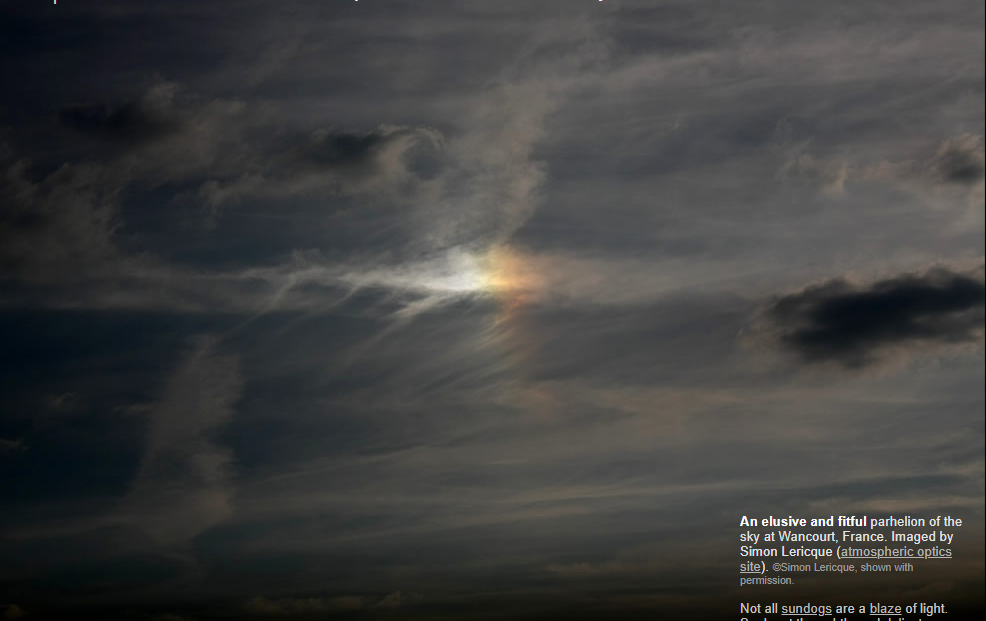Elusive Parhelion
Elusive Parhelion: Unveiling the Subtle and Delicate Sundogs
Sundogs, also known as parhelia, are not always a dazzling display of light. While many are familiar with the vibrant and prominent sundogs that occur when ice crystals align in the atmosphere, there exists a more elusive and ethereal variety. These subtle and delicate sundogs can be observed when cirrus streaks drift across specific regions of the sky, approximately 22 degrees to the left and right of the sun.
Unlike their vibrant counterparts, these elusive parhelia may only last for a few seconds before disappearing. However, if one is fortunate enough to witness a longer-lasting event, they may witness a captivating transformation as the population of plate crystals responsible for creating the sundogs shifts with the winds.
Regrettably, despite occurring every 2-3 days, these understated phenomena often go unnoticed by many observers. Their fleeting nature and delicate appearance make them easily overlooked, leading to missed opportunities to appreciate their beauty.
To better understand these elusive parhelia, it is important to delve into the science behind their formation. Sundogs are created when sunlight interacts with ice crystals in the atmosphere. These crystals act as prisms, bending and refracting the sunlight, resulting in the appearance of additional light sources on either side of the sun. When conditions are just right, these sundogs can form in a distinct "sweet spot" approximately 22 degrees away from the sun.
As the cirrus clouds move across the sky, their interaction with the sunlight can create intricate patterns and variations within the sundogs. These patterns can be influenced by factors such as crystal size, shape, and orientation, as well as atmospheric conditions like temperature and humidity. Consequently, each sighting of an elusive parhelion can be a unique and mesmerizing experience.
To increase your chances of spotting these subtle and delicate sundogs, here are a few tips:
- Be patient and observant, as these phenomena can occur sporadically throughout the day.
- Pay attention to the presence of cirrus clouds, as they often serve as the canvas upon which these elusive parhelia manifest.
- Look approximately 22 degrees to the left and right of the sun, as this is where the "sweet spots" for sundog formation are located.
- Utilize polarized sunglasses or a polarizing filter on your camera lens to enhance the visibility of these faint phenomena.
- Consider visiting areas with clear skies and minimal light pollution to maximize your chances of observing an elusive parhelion.
By actively seeking out and appreciating these understated displays of atmospheric optics, we can develop a deeper appreciation for the intricate and awe-inspiring wonders that exist within our sky. So, the next time you find yourself gazing at the sun, take a moment to look beyond its brilliance and discover the elusive parhelia that dance delicately in its wake.

An elusive and fitful parhelion of the sky at Wancourt, France. Imaged by Simon Lericque (atmospheric optics site). ©Simon Lericque, shown with permission.
Not all sundogs are a blaze of light. Seek out the subtle and delicate ones when cirrus streaks drift across the 'sweet spots 22 degrees (or more) to the left and right of the sun.
They can last for a few seconds or if longer alter and twist as the populations of plate crystals shift with the winds.
Those who seek see them every 2-3 days or so. Too many miss them all.
Note: this article has been automatically converted from the old site and may not appear as intended. You can find the original article here.
Reference Atmospheric Optics
If you use any of the definitions, information, or data presented on Atmospheric Optics, please copy the link or reference below to properly credit us as the reference source. Thank you!
-
<a href="https://atoptics.co.uk/blog/elusive-parhelion/">Elusive Parhelion</a>
-
"Elusive Parhelion". Atmospheric Optics. Accessed on November 26, 2024. https://atoptics.co.uk/blog/elusive-parhelion/.
-
"Elusive Parhelion". Atmospheric Optics, https://atoptics.co.uk/blog/elusive-parhelion/. Accessed 26 November, 2024
-
Elusive Parhelion. Atmospheric Optics. Retrieved from https://atoptics.co.uk/blog/elusive-parhelion/.